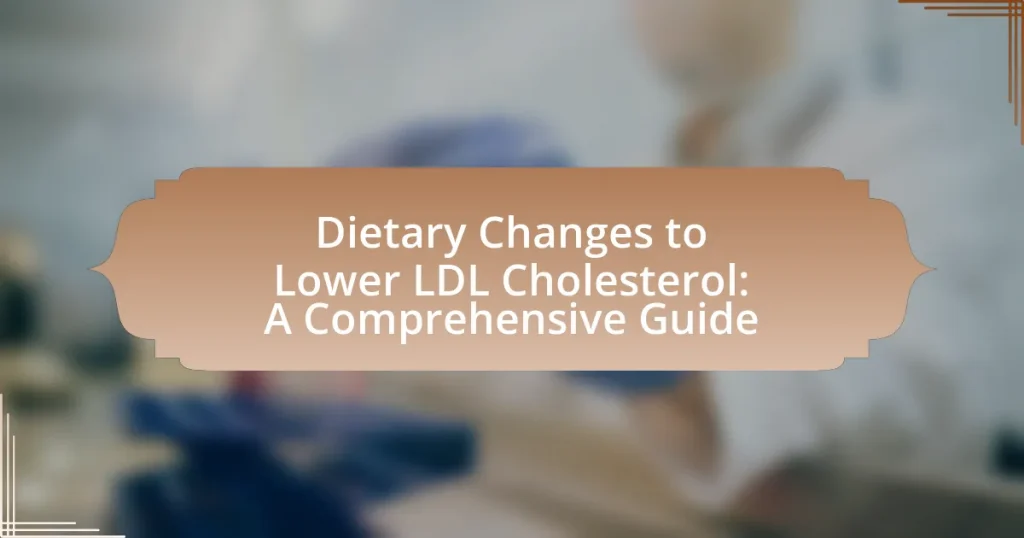The article focuses on dietary changes to lower LDL cholesterol, emphasizing the importance of a diet rich in fruits, vegetables, whole grains, and healthy fats while minimizing saturated and trans fats. It outlines how specific dietary components, such as soluble fiber and healthy fats, can significantly impact LDL cholesterol levels and overall heart health. The article also discusses the role of plant sterols, the Mediterranean diet, and practical strategies for implementing these dietary changes effectively, including meal planning and overcoming common challenges. Additionally, it highlights the health risks associated with high LDL cholesterol and the benefits of maintaining lower levels for improved cardiovascular health.

What are Dietary Changes to Lower LDL Cholesterol?
To lower LDL cholesterol, individuals should adopt a diet rich in fruits, vegetables, whole grains, and healthy fats while reducing saturated and trans fats. Consuming foods high in soluble fiber, such as oats, beans, and lentils, can help lower cholesterol levels by binding to cholesterol in the digestive system and facilitating its excretion. Additionally, incorporating fatty fish, which are high in omega-3 fatty acids, can improve heart health and lower LDL cholesterol. Research indicates that a diet low in saturated fats and high in polyunsaturated fats can reduce LDL cholesterol by 10% to 15% (Siri-Tarino et al., 2010, American Journal of Clinical Nutrition).
How do dietary changes impact LDL cholesterol levels?
Dietary changes significantly impact LDL cholesterol levels by altering the types and amounts of fats, fiber, and other nutrients consumed. For instance, reducing saturated fat intake, commonly found in red meat and full-fat dairy products, can lower LDL cholesterol by 5% to 10%, as supported by research published in the American Journal of Clinical Nutrition. Additionally, increasing soluble fiber intake from foods like oats, beans, and fruits can further reduce LDL cholesterol levels by binding cholesterol in the digestive system and promoting its excretion. Studies indicate that a diet rich in plant-based foods and healthy fats, such as those found in nuts and olive oil, can also contribute to lower LDL cholesterol levels, demonstrating the direct correlation between dietary choices and cholesterol management.
What specific dietary components influence LDL cholesterol?
Saturated fats and trans fats significantly influence LDL cholesterol levels. Saturated fats, commonly found in red meat, full-fat dairy products, and certain oils, can raise LDL cholesterol levels by increasing the liver’s production of cholesterol. Trans fats, often present in processed foods and margarine, not only raise LDL cholesterol but also lower HDL cholesterol, compounding cardiovascular risk. Research published in the American Journal of Clinical Nutrition indicates that reducing saturated fat intake can lower LDL cholesterol by approximately 10% to 15%. Additionally, dietary components such as soluble fiber, found in oats, beans, and fruits, can help lower LDL cholesterol by binding to cholesterol in the digestive system and facilitating its excretion.
How do different fats affect LDL cholesterol levels?
Different types of fats have varying effects on LDL cholesterol levels. Saturated fats, commonly found in red meat and full-fat dairy products, tend to raise LDL cholesterol levels. In contrast, unsaturated fats, particularly monounsaturated and polyunsaturated fats found in olive oil, avocados, and fatty fish, can lower LDL cholesterol levels. Research published in the American Journal of Clinical Nutrition indicates that replacing saturated fats with unsaturated fats can significantly reduce LDL cholesterol, highlighting the importance of fat type in dietary choices for heart health.
Why is lowering LDL cholesterol important for health?
Lowering LDL cholesterol is important for health because high levels of LDL cholesterol are associated with an increased risk of cardiovascular diseases, including heart attacks and strokes. Research indicates that elevated LDL cholesterol contributes to the buildup of plaque in arteries, leading to atherosclerosis, which narrows and hardens the arteries. According to the American Heart Association, reducing LDL cholesterol levels can significantly decrease the likelihood of heart disease and improve overall cardiovascular health.
What health risks are associated with high LDL cholesterol?
High LDL cholesterol is associated with several significant health risks, primarily cardiovascular diseases. Elevated levels of LDL cholesterol can lead to the buildup of plaque in the arteries, a condition known as atherosclerosis, which increases the risk of heart attacks and strokes. According to the American Heart Association, individuals with high LDL cholesterol levels are more likely to experience coronary artery disease, which can result in angina and heart failure. Additionally, high LDL cholesterol is linked to peripheral artery disease, which can cause pain and mobility issues due to reduced blood flow.
How does lowering LDL cholesterol improve overall health?
Lowering LDL cholesterol improves overall health by reducing the risk of cardiovascular diseases, including heart attacks and strokes. High levels of LDL cholesterol contribute to the buildup of plaque in arteries, leading to atherosclerosis, which narrows blood vessels and restricts blood flow. Studies indicate that lowering LDL cholesterol by 1% can reduce the risk of heart disease by approximately 2%. Additionally, maintaining lower LDL levels is associated with improved blood circulation and overall heart function, enhancing longevity and quality of life.
What are the general guidelines for dietary changes?
General guidelines for dietary changes to lower LDL cholesterol include increasing the intake of soluble fiber, such as oats and legumes, and incorporating healthy fats from sources like olive oil and avocados. Additionally, reducing saturated fats found in red meat and full-fat dairy products is essential, as studies show that these fats can raise LDL cholesterol levels. Replacing refined carbohydrates with whole grains and increasing the consumption of fruits and vegetables can also contribute to better cholesterol management. Research indicates that these dietary modifications can lead to significant reductions in LDL cholesterol, supporting heart health.
What types of foods should be included in a cholesterol-lowering diet?
A cholesterol-lowering diet should include foods high in soluble fiber, healthy fats, and plant sterols. Foods such as oats, barley, beans, lentils, fruits like apples and citrus, vegetables, nuts, seeds, and fatty fish are effective in reducing LDL cholesterol levels. Research indicates that soluble fiber can lower cholesterol absorption in the bloodstream, while healthy fats, particularly omega-3 fatty acids found in fish, can improve heart health. Additionally, plant sterols, found in fortified foods, can help block cholesterol absorption.
Which foods should be avoided to lower LDL cholesterol?
To lower LDL cholesterol, foods high in saturated fats and trans fats should be avoided. Saturated fats are commonly found in red meat, full-fat dairy products, and certain oils like coconut and palm oil. Trans fats are often present in processed foods, such as baked goods, fried foods, and margarine. Research indicates that reducing intake of these fats can significantly lower LDL cholesterol levels, as evidenced by studies published in the American Journal of Clinical Nutrition, which show that replacing saturated fats with unsaturated fats can lead to a decrease in LDL cholesterol.

What specific dietary strategies can help lower LDL cholesterol?
Specific dietary strategies that can help lower LDL cholesterol include increasing soluble fiber intake, consuming healthy fats, and incorporating plant sterols and stanols. Increasing soluble fiber, found in foods like oats, beans, and fruits, can reduce cholesterol absorption in the bloodstream. Healthy fats, such as those from olive oil, avocados, and nuts, can replace saturated fats, which are known to raise LDL levels. Additionally, plant sterols and stanols, present in fortified foods, can block cholesterol absorption and have been shown to lower LDL cholesterol by about 5-15% when consumed in adequate amounts.
How can increasing fiber intake lower LDL cholesterol?
Increasing fiber intake can lower LDL cholesterol by enhancing the excretion of bile acids and reducing cholesterol absorption in the intestines. Soluble fiber, found in foods like oats, beans, and fruits, binds to bile acids in the digestive system, which forces the body to use cholesterol to produce more bile acids, thereby lowering the overall cholesterol levels in the bloodstream. Research indicates that a daily intake of 5 to 10 grams of soluble fiber can reduce LDL cholesterol by approximately 5% to 10%. This mechanism is supported by studies such as one published in the American Journal of Clinical Nutrition, which demonstrated that increased soluble fiber intake significantly correlates with reduced LDL cholesterol levels.
What are the best sources of soluble fiber?
The best sources of soluble fiber include oats, barley, nuts, seeds, beans, lentils, peas, and certain fruits such as apples, citrus fruits, and berries. Soluble fiber dissolves in water to form a gel-like substance, which can help lower LDL cholesterol levels by binding to cholesterol in the digestive system and promoting its excretion. Studies have shown that diets high in soluble fiber can significantly reduce cholesterol levels; for example, a review published in the American Journal of Clinical Nutrition found that increasing soluble fiber intake by 5 to 10 grams per day can lower LDL cholesterol by 5% to 10%.
How does fiber consumption affect cholesterol absorption?
Fiber consumption reduces cholesterol absorption by binding to bile acids in the intestine, which leads to increased excretion of cholesterol. When soluble fiber, such as that found in oats and legumes, is consumed, it forms a gel-like substance that traps cholesterol and bile acids, preventing their reabsorption into the bloodstream. This mechanism has been supported by studies indicating that diets high in soluble fiber can lower LDL cholesterol levels by 5% to 10%. For instance, a meta-analysis published in the American Journal of Clinical Nutrition found that increasing soluble fiber intake significantly correlates with reduced serum cholesterol levels, demonstrating the effectiveness of fiber in managing cholesterol absorption.
What role do plant sterols and stanols play in cholesterol management?
Plant sterols and stanols play a significant role in cholesterol management by reducing low-density lipoprotein (LDL) cholesterol levels. These compounds, found in various plant-based foods, work by blocking the absorption of cholesterol in the intestines, leading to a decrease in overall cholesterol levels in the bloodstream. Research indicates that consuming 2 grams of plant sterols or stanols daily can lower LDL cholesterol by 5% to 15%, as demonstrated in studies published in the American Journal of Clinical Nutrition. This reduction is particularly beneficial for individuals at risk of cardiovascular diseases, making plant sterols and stanols an effective dietary strategy for managing cholesterol levels.
How can foods fortified with plant sterols be incorporated into the diet?
Foods fortified with plant sterols can be incorporated into the diet by replacing regular fats and oils with sterol-enriched alternatives, such as margarine or spreads. These fortified foods can also be added to smoothies, yogurt, or salad dressings to enhance daily intake. Research indicates that consuming 2 grams of plant sterols daily can lower LDL cholesterol levels by 5% to 15%, making their inclusion beneficial for heart health.
What is the recommended daily intake of plant sterols?
The recommended daily intake of plant sterols is 2 to 3 grams. This amount has been shown to effectively lower LDL cholesterol levels, as supported by research indicating that consuming this quantity can reduce cholesterol absorption in the intestines. Studies, including those published in the Journal of Nutrition, confirm that a daily intake of 2 grams of plant sterols can lead to a reduction in LDL cholesterol by approximately 5% to 15%.
How does the Mediterranean diet contribute to lower LDL cholesterol?
The Mediterranean diet contributes to lower LDL cholesterol primarily through its emphasis on healthy fats, fiber, and nutrient-rich foods. This diet includes high amounts of monounsaturated fats from olive oil, which have been shown to reduce LDL cholesterol levels. Additionally, the Mediterranean diet is rich in fruits, vegetables, whole grains, and legumes, all of which provide soluble fiber that helps lower cholesterol absorption in the bloodstream. Research published in the “New England Journal of Medicine” by Estruch et al. (2013) demonstrated that participants following a Mediterranean diet experienced a significant reduction in LDL cholesterol compared to those on a low-fat diet.
What are the key components of the Mediterranean diet?
The key components of the Mediterranean diet include a high intake of fruits, vegetables, whole grains, legumes, nuts, and olive oil, along with moderate consumption of fish and poultry, and limited intake of red meat and dairy products. This diet emphasizes plant-based foods and healthy fats, which contribute to lower LDL cholesterol levels. Research indicates that adherence to the Mediterranean diet is associated with a reduced risk of cardiovascular diseases, as evidenced by a study published in the New England Journal of Medicine, which found that participants following this diet had a 30% lower risk of heart-related events compared to those on a low-fat diet.
How can one transition to a Mediterranean-style eating pattern?
To transition to a Mediterranean-style eating pattern, one should focus on incorporating more fruits, vegetables, whole grains, legumes, nuts, and healthy fats, particularly olive oil, while reducing red meat and processed foods. This dietary approach emphasizes plant-based foods, which are rich in fiber and antioxidants, contributing to lower LDL cholesterol levels. Research indicates that following a Mediterranean diet can lead to a significant reduction in cardiovascular risk factors, including LDL cholesterol, as evidenced by a study published in the New England Journal of Medicine, which found that participants adhering to this diet experienced a 30% reduction in cardiovascular events.

What practical tips can help implement dietary changes effectively?
To implement dietary changes effectively, individuals should start by setting specific, achievable goals, such as reducing saturated fat intake or increasing fiber consumption. Research indicates that clear, measurable objectives enhance adherence to dietary modifications, as they provide direction and motivation. Additionally, meal planning and preparation can significantly aid in maintaining these changes; studies show that individuals who plan meals are more likely to make healthier food choices and stick to their dietary goals. Keeping a food diary can also be beneficial, as tracking food intake has been associated with greater weight loss and improved dietary habits. Lastly, seeking support from healthcare professionals or joining a community group can provide encouragement and accountability, which are crucial for sustaining long-term dietary changes.
How can meal planning assist in lowering LDL cholesterol?
Meal planning can assist in lowering LDL cholesterol by promoting the consumption of heart-healthy foods while reducing intake of saturated fats and trans fats. By organizing meals in advance, individuals can prioritize foods rich in soluble fiber, such as oats, beans, and fruits, which have been shown to lower LDL cholesterol levels. Additionally, meal planning helps in avoiding processed foods high in unhealthy fats, as evidenced by a study published in the Journal of the American College of Cardiology, which found that dietary patterns emphasizing whole foods can significantly reduce cholesterol levels. This structured approach to eating not only supports healthier choices but also aids in portion control, further contributing to improved cholesterol management.
What are some easy meal prep ideas for a cholesterol-lowering diet?
Easy meal prep ideas for a cholesterol-lowering diet include preparing oatmeal with fruits, making quinoa salads with vegetables, and cooking lean proteins like chicken or fish with steamed broccoli. Oatmeal is high in soluble fiber, which can help lower LDL cholesterol levels, while quinoa is a whole grain that provides essential nutrients without saturated fats. Lean proteins, such as skinless chicken breast or fatty fish like salmon, are beneficial due to their lower saturated fat content and omega-3 fatty acids, which can improve heart health. These meal prep options are simple to prepare in advance and can be stored for several days, making them convenient for maintaining a cholesterol-lowering diet.
How can one stay motivated to maintain dietary changes?
To stay motivated in maintaining dietary changes, one should set clear, achievable goals and track progress regularly. Research indicates that individuals who set specific dietary goals are more likely to adhere to their plans; for instance, a study published in the Journal of Nutrition found that goal-setting significantly improved dietary adherence among participants. Additionally, finding a support system, such as friends or online communities, can enhance motivation, as social support has been shown to positively influence dietary behavior change. Regularly reminding oneself of the health benefits, such as reduced LDL cholesterol levels and improved overall health, can also reinforce commitment to dietary changes.
What common challenges might arise when changing dietary habits?
Common challenges that might arise when changing dietary habits include cravings for familiar foods, social pressures during meals, and difficulty in meal planning. Cravings can lead to relapse into old eating patterns, as studies show that the brain’s reward system is activated by high-fat and high-sugar foods, making them hard to resist. Social pressures can complicate adherence to new dietary choices, especially in social settings where unhealthy options are prevalent. Additionally, meal planning can be overwhelming, as research indicates that individuals often struggle to create balanced meals that align with their new dietary goals, leading to frustration and potential abandonment of dietary changes.
How can one overcome cravings for unhealthy foods?
To overcome cravings for unhealthy foods, one can implement strategies such as increasing protein intake, staying hydrated, and incorporating more fiber-rich foods into the diet. Research indicates that higher protein consumption can reduce hunger and cravings, as protein promotes satiety more effectively than carbohydrates or fats. Additionally, drinking water before meals can help reduce appetite, as dehydration is often mistaken for hunger. Fiber-rich foods, such as fruits, vegetables, and whole grains, slow digestion and help maintain stable blood sugar levels, further curbing cravings. These methods are supported by studies showing that dietary adjustments can significantly influence eating behaviors and cravings.
What strategies can help when dining out or traveling?
When dining out or traveling, choosing meals that are low in saturated fats and high in fiber can effectively lower LDL cholesterol levels. Opt for grilled, baked, or steamed dishes instead of fried options, and prioritize whole grains, fruits, and vegetables. Research indicates that diets rich in soluble fiber, such as oats and legumes, can reduce LDL cholesterol by up to 10%. Additionally, asking for dressings and sauces on the side allows for better control over calorie and fat intake, further supporting heart health.










